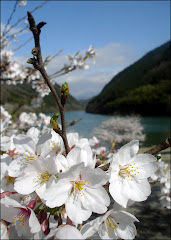
The geiko Takamaru leads a young new maiko celebrating her first Hassaku.
The changing of seasons has long been observed and celebrated with festivals and sacred rites throughout the world. In ancient Japan, these celebrations and rituals, important for strengthening the bonds between gods and men, as well as among the farmers, were woven with the seasonal rhythms of growing rice, a sacred act on which their lives depended and their culture flourished. From planting to polishing, the roots of the agragarian culture penetrated every aspect of their lives, measured by and dedicated to the cultivation of okome, "honorable rice", the foundation of Japanese culture as we know it today.
A family of geiko and maiko cross the street according to rank, with senior geiko at the front the most junior maiko following behind.
So what does rice have to do with Hassaku? According to Japan's old lunar calender, the first day of a the new month, when the moon was not yet visible, was called
tsuitachi 朔 or
saku. As the first day of the eight month approached, the brilliant green rice filds began to ripen and bear fruit. With harvest near, the peasant farmers offered these first fruits to their patrons in a show of gratitude with hope for a good harvest.

The custom caught on, and soon even samurai families and members of the imperial court began offering the "first fruits" to those they felt indebted to as a way of expressing their gratitude. This festival, held on the first day of the eighth month, or
Hassaku, became known as "
Tanomi" ( 田 ta , or rice field, の no, showing possesion, and 実 mi, fruit ), the "Fruit of the Rice Feilds". A play on words, "
Tanomi" (頼み), meaning request or favor, also served as a petition to the gods for a good harvest.
In Gion Kobu, Hassaku is a lot like a New Year's. In the heat of the summer, robed in the most formal black kimono, young geiko and maiko visit the teahouses, teachers, senior geiko and establishments they depend upon to express their gratitude for their support and beg their favor in the future.

A group of geiko greet each other with a bow as they make their Hassaku rounds.
More photos coming soon!





 Kotoha wears another rare kanzashi.
Kotoha wears another rare kanzashi.

 Senior maiko wear the Yakko Shimada hairstyle.
Senior maiko wear the Yakko Shimada hairstyle. The difference is easily observable, as seen above.
The difference is easily observable, as seen above.


 Could they be any cooler? Maybe... If they were Shinigami! (^_<)
Could they be any cooler? Maybe... If they were Shinigami! (^_<) 







 Having paid their respects, Takamaru leads the girls to their next stop
Having paid their respects, Takamaru leads the girls to their next stop








 A group of geiko greet each other with a bow as they make their Hassaku rounds.
A group of geiko greet each other with a bow as they make their Hassaku rounds.

